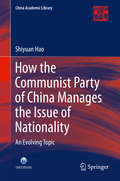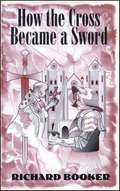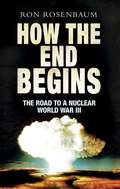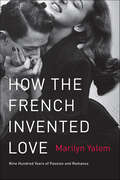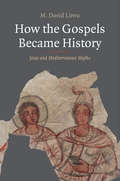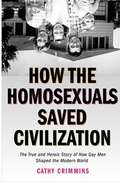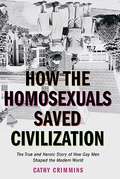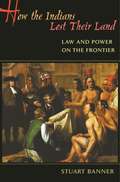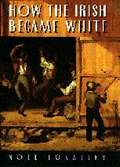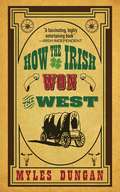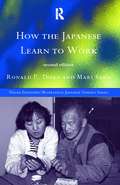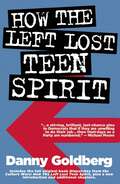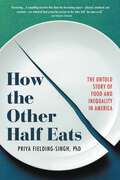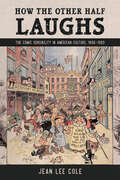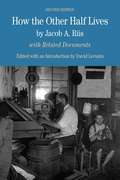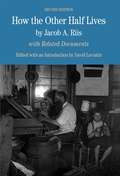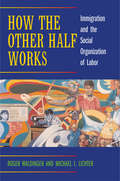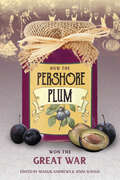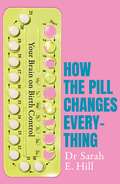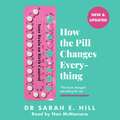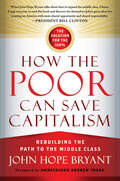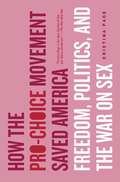- Table View
- List View
How the Communist Party of China Manages the Issue of Nationality
by Shiyuan HaoThis book introduces the background of China's issue of nationality from the very beginning. Throughout the country's history, all the nationalities that lived and prospered on Chinese land created a pattern of cultural diversity within national unity through their interaction and integration. The formation of this pattern is due not only to the geographical fact that China covers a broad expanse on the Asian continent but also to the historical fact that it is home to disparate and ancient human heritages, and to culturally diverse historical sources. The book's five chapters explain the evolution of the CPC's policy towards nationalities. At the time of the PRC's founding, the Common Program (in essence an interim Constitution) passed by the Chinese People's Political Consultative Congress (which was composed of people from all sectors of society and all of China's nationalities) not only declared that people of all China's nationalities had equal rights, but also stipulated that: regional national autonomy would be practiced in all areas where minority nationalities were concentrated; that all nationalities had the right to develop their native languages and culture and to maintain or reform their customs and religious beliefs; and also mandated that people's governments support the development of minority nati onalities in the areas of politics, the economy, culture and education. In the final section, the book demonstrates that the subject of how the CPC addresses nationality-related issues is a dynamic one that encompasses the past, present and future, and is simultaneously an answer, a process and a question.
How the Cross Became a Sword
by Richard BookerThis publication explains the events that separated Christianity from its Jewish roots and established anti-Semitism as official church doctrine.
How the End Begins: The Road to a Nuclear World War III
by Ron RosenbaumEach chapter of the How the World Ends deconstructs the dangers we face. Rosenbaum begins by showing all the ways the post-Cold War order that tried to impose a set of rules of averting a nuclear mistake has fallen apart. In chapter 2, he describes the journey of one Bruce Blair, once a missile launcher, whose experience inside the nuclear establishment left him alarmed about its vulnerabilities. Chapter 3 looks at nuclear war from the Russian side, using the architect of that nation's early warning system as a focus. Chapter 4 looks at how the Bush Administration helped pushed the world closer to a nuclear conflict by rewriting the rules of deterrence. Chapter 5 describes all the ways the international incidents we have seen - Georgia, the Israeli raid on Syria, the Iranian moves - are evidence that some governments have shown a willingness to move closer to the brink of a conflict involving nuclear weapons. The rest of the book looks at the broader nuclear issues facing the world in the 21st century: What is deterrence? Who can claim to have it? How many nuclear weapons can we live with? Is zero really possible? In other words: Can we undream the nightmare?
How the French Invented Love: Nine Hundred Years of Passion and Romance
by Marilyn Yalom“Absolutely marvelous…lively and learned….Marilyn Yalom’s book is a distinguished contribution to our experience of a great literature, as well as an endearing memoir.” —Diane Johnson, author of Lulu in Marrakech and Le Divorce“[An] enchanting tour of French literature—from Abelard and Heloise in the 12th century to Marguerite Duras in the 20th and Philippe Sollers in the 21st.” —Publishers Weekly (starred review)How the French Invented Love is an entertaining and masterful history of love à la française by acclaimed scholar Marilyn Yalom. Spanning the Middle Ages to the present, Yalom explores a love-obsessed culture through its great works of literature—from Moliere’s comic love to the tragic love of Racine, from the existential love of Simone de Beauvoir and Jean-Paul Sartre to the romanticism of George Sand and Alfred de Musset. A thoroughly engaging homage to French culture and literature interlaced with the author’s delicious personal anecdotes, How the French Invented Love is ideal for fans of Alain de Botton, Adam Gopnik, and Simon Schama.
How the Gospels Became History: Jesus and Mediterranean Myths (Synkrisis)
by M. David LitwaA compelling comparison of the gospels and Greco-Roman mythology which shows that the gospels were not perceived as myths, but as historical records Did the early Christians believe their myths? Like most ancient—and modern—people, early Christians made efforts to present their myths in the most believable ways. In this eye-opening work, M. David Litwa explores how and why what later became the four canonical gospels take on a historical cast that remains vitally important for many Christians today. Offering an in-depth comparison with other Greco-Roman stories that have been shaped to seem like history, Litwa shows how the evangelists responded to the pressures of Greco-Roman literary culture by using well-known historiographical tropes such as the mention of famous rulers and kings, geographical notices, the introduction of eyewitnesses, vivid presentation, alternative reports, and so on. In this way, the evangelists deliberately shaped myths about Jesus into historical discourse to maximize their believability for ancient audiences.
How the Homosexuals Saved Civilization: The True and Heroic Story of How Gay Men Shaped the Modern World
by Cathy CrimminsA shrewd and irreverent cultural history of the customs, fashions, and figures of gay life in the twentieth and the early twenty-first centuries--and how they have changed all of us for the better. The "global queering" of America has been gradually shaping the way straight people talk, think, dress, and eat. Over the past fifty years, the line between what is "straight" and what is "gay" has blurred to the point that most heterosexuals are unaware of the vast contributions gay men have made to American culture. How the Homosexuals Saved Civilization presents a broad yet incisive look at how an unusual "immigrant" group, homosexual men, have become so influential on mainstream American culture. The general public's tastes and consumer choices in food, fashion, humor, literature, and body image are becoming decidedly more gay. And America has shown a real interest in TV shows with gay content and themes, such as Queer Eye for the Straight Guy; Will & Grace; and Six Feet Under. Overall, it's hip to be gay, even if you're straight. How the Homosexuals Saved Civilization tells us something about ourselves as a society. It celebrates the unique perspective of gay men and explains how essential their vitality has been to our civilization.
How the Homosexuals Saved Civilization: The Time and Heroic Story of How Gay Men Shaped the Modern World
by Cathy CrimminsA shrewd and irreverent cultural history of the customs, fashions, and figures of gay life in the twentieth and the early twenty-first centuries-and how they have changed all of us for the better. <P> The "global queering" of America has been gradually shaping the way straight people talk, think, dress, and eat. Over the past fifty years, the line between what is "straight" and what is "gay" has blurred to the point that most heterosexuals are unaware of the vast contributions gay men have made to American culture. <P> How the Homosexuals Saved Civilization presents a broad yet incisive look at how an unusual "immigrant" group, homosexual men, have become so influential on mainstream American culture. The general public's tastes and consumer choices in food, fashion, humor, literature, and body image are becoming decidedly more gay. And America has shown a real interest in TV shows with gay content and themes, such as Queer Eye for the Straight Guy; Will & Grace; and Six Feet Under. Overall, it's hip to be gay, even if you're straight. How the Homosexuals Saved Civilization tells us something about ourselves as a society. It celebrates the unique perspective of gay men and explains how essential their vitality has been to our civilization.
How the Indians Lost Their Land: Law and Power on the Frontier
by Stuart BannerBetween the early seventeenth century and the early twentieth,nearly all the land in the United States was transferred from AmericanIndians to whites. This dramatic transformation has been understood in two very different ways--as a series of consensual transactions, but also as a process of violent conquest. Both views cannot be correct. How did Indians actually lose their land? Stuart Banner provides the first comprehensive answer. He argues that neither simple coercion nor simple consent reflects the complicated legal history of land transfers. Instead, time, place, and the balance of power between Indians and settlers decided the outcome of land struggles. As whites' power grew, they were able to establish the legal institutions and the rules by which land transactions would be made and enforced. This story of America's colonization remains a story of power, but a more complex kind of power than historians have acknowledged. It is a story in which military force was less important than the power to shape the legal framework within which land would be owned. As a result, white Americans--from eastern cities to the western frontiers--could believe they were buying land from the Indians the same way they bought land from one another. How the Indians Lost Their Land dramatically reveals how subtle changes in the law can determine the fate of a nation, and our understanding of the past.
How the Irish Became White
by Noel IgnatievOne way to be white, according to Ignatiev (history, Massachusetts College of Art) is to make sure nobody thinks you are Black. Ignatiev, also well known as a co-founder of the journal Race Traitor, notes that the Irish fled a homeland under foreign occupation and a caste system that reduced them to the lowest form of humanity. When they came to America they found their identity was defined instead by the color of their skin. Quickly, the oppressed became the oppressors and the new Irish immigrants proved they could be more brutal in their oppression of African Americans than those who had come before, with the Irish Protestant Ascendancy serving as role models. Published in 1995 and a source of controversy ever since, this is a significant part of Ignatiev's stated agenda to abolish the white race. Annotation ©2009 Book News, Inc., Portland, OR (booknews.com)
How the Irish Won the West
by Myles DunganHere is the full story of the Irish immigrants and their decedents whose hard work helped make the West what it is today. Learn about the Irish members of the Donner party, forced to consume human flesh to survive the winter; mountain men like Thomas Fitzpatrick, who discovered the South Pass through the Rockies; Ellen "Nellie" Cashman, who ran boarding houses and bought and sold claims in Alaska, Arizona, and Nevada; and Maggie Hall, who became known as the "whore with a heart of gold." A fascinating and entertaining look at the history of the American West, this book will surprise many and make every Irish American proud.
How the Japanese Learn to Work (Nissan Institute/Routledge Japanese Studies)
by R. P. Dore Mari SakoJapan is regarded as a world leader in the field of education and training for improved economic performance. Yet success in Japan is often achieved by going against what is regarded as ideal practice elsewhere. This book offers the most comprehensive review available in English of the many facets of Japanese vocational education and training. Covering the system from primary education through to in job-training offered by companies, this book provides a detailed study of current practice giving equal emphasis to formal training in explicitly vocational courses, and informal training in factories, shops and offices.The authors analyse the difference between substantive 'person-changing' training and mere 'ability-labelling.' They raise important questions, such as: To what extent does the need to package skills to provide convenient qualifications distort the actual training given? How efficient is it to rely on professional trainers to certify the acquisition of skills, rather than run separate testing systems? The authors reveal how, in Japanese companies, employees are strongly motivated by pride in the successful execution of their jobs, and that much company training is carried out by colleagues.
How the Left Lost Teen Spirit (And how they're getting it back!): (and How They're Getting It Back!)
by Danny GoldbergIncludes Goldberg's groundbreaking book Dispatches from the Culture Wars, plus a new author introduction and additional chapters. “Danny Goldberg’s new book is a stirring, brilliant, last-chance plea to Democrats that if they are unwilling to do their job—be a voice for working people, young people, women, the elderly, the poor and people of color, (in other words, for the MAJORITY of the country)—then their days as a party are numbered. Years from now, if the Democrats have long faded from American memory, anthropologists and historians will ask, ‘Didn’t any of them read this book by Danny Goldberg?’”—Michael Moore “Danny Goldberg has written with pinpoint accuracy an important memoir filled with fascinating insights. His searing insights should be required reading for anyone concerned with the state of democratic politics in this country.”—Reverend Jesse L. Jackson, Sr. “If Lester Bangs and Maureen Dowd had a love child, he’d have written this book.”—Arianna Huffington “Danny Goldberg’s memoir contains the powerful reflections of the most progressive activist in the recording industry. His candor, vision and sense of humor is infectious.”—Cornel West When did American government become the enemy of American pop culture? Music insider and progressive activist Danny Goldberg has spent decades tuning in to the rhythms and voices that speak straight to the hearts and desires of America’s youth. In that time, one fact has become increasingly clear: our venerable political leaders are tone deaf. In this startling, provocative book, Goldberg shows how today’s professional public servants have managed to achieve nothing less than the indefensible, wholesale alienation of an entire generation.
How the Maya Built Their World
by Elliot M. AbramsMaya architecture is often described as "massive" and "monumental," but experiments at Copan, Honduras, convinced Elliot Abrams that 300 people could have built one of the large palaces there in only 100 days. In this groundbreaking work, Abrams explicates his theory of architectural energetics, which involves translating structures into volumes of raw and manufactured materials that are then multiplied by the time required for their production and assembly to determine the labor costs of past construction efforts. Applying this method to residential structures of the Late Classic period (A. D. 700-900) at Copan leads Abrams to posit a six-tiered hierarchic social structure of political decision making, ranging from a stratified elite to low-ranking commoners. By comparing the labor costs of construction and other economic activities, he also prompts a reconsideration of the effects of royal construction demands on commoners.
How the Other Half Eats: The Untold Story of Food and Inequality in America
by Priya Fielding-SinghA &“deeply empathetic&” (Publishers Weekly, starred review) &“must-read&” (Marion Nestle) that &“weaves lyrical storytelling and fascinating research into a compelling narrative&” (Chronicle Review) to look at dietary differences along class lines and nutritional disparities in America, illuminating exactly how inequality starts on the dinner plate.Inequality in America manifests in many ways, but perhaps nowhere more than in how we eat. From her years of field research, sociologist and ethnographer Priya Fielding-Singh brings us into the kitchens of dozens of families from varied educational, economic, and ethnoracial backgrounds to explore how—and why—we eat the way we do. We get to know four families intimately: the Bakers, a Black family living below the federal poverty line; the Williamses, a working-class white family just above it; the Ortegas, a middle-class Latinx family; and the Cains, an affluent white family.Whether it's worrying about how far pantry provisions can stretch or whether there's enough time to get dinner on the table before soccer practice, all families have unique experiences that reveal their particular dietary constraints and challenges. By diving into the nuances of these families&’ lives, Fielding-Singh lays bare the limits of efforts narrowly focused on improving families&’ food access. Instead, she reveals how being rich or poor in America impacts something even more fundamental than the food families can afford: these experiences impact the very meaning of food itself.Packed with lyrical storytelling and groundbreaking research, as well as Fielding-Singh&’s personal experiences with food as a biracial, South Asian American woman, How the Other Half Eats illuminates exactly how inequality starts on the dinner plate. Once you&’ve taken a seat at tables across America, you&’ll never think about class, food, and public health the same way again.
How the Other Half Laughs: The Comic Sensibility in American Culture, 1895-1920
by Jean Lee ColeHonorable Mention Recipient for the Charles Hatfield Book PrizeTaking up the role of laughter in society, How the Other Half Laughs: The Comic Sensibility in American Culture, 1895–1920 examines an era in which the US population was becoming increasingly multiethnic and multiracial. Comic artists and writers, hoping to create works that would appeal to a diverse audience, had to formulate a method for making the “other half” laugh. In magazine fiction, vaudeville, and the comic strip, the oppressive conditions of the poor and the marginalized were portrayed unflinchingly, yet with a distinctly comic sensibility that grew out of caricature and ethnic humor.Author Jean Lee Cole analyzes Progressive Era popular culture, providing a critical angle to approach visual and literary humor about ethnicity—how avenues of comedy serve as expressions of solidarity, commiseration, and empowerment. Cole’s argument centers on the comic sensibility, which she defines as a performative act that fosters feelings of solidarity and community among the marginalized. Cole stresses the connections between the worlds of art, journalism, and literature and the people who produced them—including George Herriman, R. F. Outcault, Rudolph Dirks, Jimmy Swinnerton, George Luks, and William Glackens—and traces the form’s emergence in the pages of Joseph Pulitzer’s New York World and William Randolph Hearst’s Journal-American and how it influenced popular fiction, illustration, and art. How the Other Half Laughs restores the newspaper comic strip to its rightful place as a transformative element of American culture at the turn into the twentieth century.
How the Other Half Lives: Studies among the Tenements of New York (Second Edition) (The Bedford Series in History and Culture)
by Jacob A. RiisJacob Riis's famed 1890 photo-text addressed the problems of tenement housing, immigration, and urban life and work at the beginning of the Progressive era. David Leviatin edited this complete edition of How the Other Half Lives to be as faithful to Riis's original text and photography as possible. Uncropped prints of Riis's original photographs replace the faded halftones and drawings from photographs that were included in the 1890 edition. Related documents added to the second edition include a stenographic report of one of Riis's lantern-slide lectures that demonstrates Riis's melodramatic techniques and the reaction of his audience, and five drawings that reveal the subtle but important ways Riis's photographs were edited when they were reinterpreted as illustrations in the 1890 edition. The book's provocative introduction now addresses Riis's ethnic and racial stereotyping and includes a map of New York's Lower East Side in the 1890s. A new list of illustrations and expanded chronology, questions for consideration, and selected bibliography provide additional support.
How the Other Half Lives (The Bedford Series in History and Culture #110)
by Jacob A. RiisJacob Riis's famed 1890 photo-text addressed the problems of tenement housing, immigration, and urban life and work at the beginning of the Progressive era. David Leviatin edited this complete edition of How the Other Half Lives to be as faithful to Riis's original text and photography as possible. Uncropped prints of Riis's original photographs replace the faded halftones and drawings from photographs that were included in the 1890 edition. Related documents added to the second edition include a stenographic report of one of Riis's lantern-slide lectures that demonstrates Riis's melodramatic techniques and the reaction of his audience, and five drawings that reveal the subtle but important ways Riis's photographs were edited when they were reinterpreted as illustrations in the 1890 edition. The book's provocative introduction now addresses Riis's ethnic and racial stereotyping and includes a map of New York's Lower East Side in the 1890s. A new list of illustrations and expanded chronology, questions for consideration, and selected bibliography provide additional support.
How the Other Half Works
by Roger Waldinger Michael I. LichterHow the Other Half Works solves the riddle of America's contemporary immigration puzzle: why an increasingly high-tech society has use for so many immigrants who lack the basic skills that today's economy seems to demand. In clear and engaging style, Waldinger and Lichter isolate the key factors that explain the presence of unskilled immigrants in our midst. Focusing on Los Angeles, the capital of today's immigrant America, this hard-hitting book elucidates the other side of the new economy, showing that hiring is finding not so much "one's own kind" but rather the "right kind" to fit the demeaning, but indispensable, jobs many American workers disdain.
How the Ox Star Fell from Heaven
by Lily T. Hong Ann FayA Chinese folk tale which explains why the ox was banished from heaven to become the farmer's beast of burden.
How the Pershore Plum Won the Great War
by Maggie Andrews Jenni WaughThe First World War was won not just on the battlefields but on the Home Front, by the men, women and children left behind. This book explores the lives of the people of Pershore and the surrounding district in wartime, drawing on their memories, letters, postcards, photographs, leaflets and recipes to demonstrate how their hard work in cultivating and preserving fruit and vegetables helped to win the Great War. Pershore plums were used to make jam for the troops; but ensuring these and other fruits and vegetables were grown and harvested required the labour of land girls, Boy Scouts, schoolchildren, Irish labourers and Belgian refugees. When submarine warfare intensified, food shortages occurred and it became vital for Britain to grow more and eat less food. Housewives faced many challenges in feeding their families and so in 1916 the Pershore Women’s Institute was formed, providing many women with practical help and companionship during some of Britain’s darkest hours in history.
How the Pill Changes Everything: Your Brain on Birth Control
by Sarah E HillTHE PILLChanges your brainAlters your stress responseCan increase your risk of depressionAffects your choice of mate selectionHormonal birth control is taken by millions of women around the world every day. Yet until recently we knew very little about how the Pill affects the non-reproductive systems of the female body, because research on these other systems was conducted almost exclusively on men. In her trailblazing book, Dr Sarah Hill uses the latest science to reveal how the Pill is changing women and the world, for better and worse. She puts the power back in your hands to make smarter, more informed choices about your health and your hormones.IT'S EVERYTHING YOUR DOCTOR NEVER TOLD YOU
How the Pill Changes Everything: Your Brain on Birth Control
by Sarah E Hill'It's time for all of us to join together to ask science for some new choices and for more information about what happens to us with the choices we have. We shouldn't have to change who we are to protect ourselves from pregnancy, and we should know enough about how our own bodies work to recognize that this is exactly what we're doing when we go on the birth control pill' Hormonal contraception is something most women will use at some point during their life. But the reach of the pill goes far beyond the small number of targeted effects we take it for. It affects almost every system in our body.Column inches and anecdotal conversations prove there are many questions about the pill and its effects yet until now we have known very little about. In this trailblazing book expert psychologist Dr Hill reveals the latest science on the pill, and how it's changing women and the world, for better and for worse. Dr Hill examines cutting-edge research, some of it conducted in her own lab, that shows how the pill affects everything from stress response to autoimmune disorders, mate selection to declining levels of male achievement. Some of her findings are shocking, others will simply verify things you suspected for a long time, but figured were all in your head. Dr Hill signals a rallying cry for better science - for too long women have been understudied as research subjects. Their cycles are more complicated, it's more expensive to do research on them, and scientists are under so much pressure to publish that it's often easier to just use a largely male testing pool, or one that ignores important factors for women. This is your Brain on Birth Control will open your eyes and put you in a position of power. It provides the latest science so that you can understand the risks, weigh up the costs and make smarter, more informed choices about your health and hormones.
How the Poor Can Save Capitalism: Rebuilding the Path to the Middle Class
by Andrew Young John BryantJohn Hope Bryant, successful self-made businessman and founder of the nonprofit Operation HOPE, says business and political leaders are ignoring the one force that could truly re-energize the stalled American economy: the poor. If we give poor communities the right tools, policies, and inspiration, he argues, they will be able to lift themselves up into the middle class and become a new generation of customers and entrepreneurs. Raised in poverty-stricken, gang-infested South Central Los Angeles, Bryant saw firsthand how our institutions have abandoned the poor. He details how business loans, home loans, and financial investments have vanished from their communities. After decades of deprivation, the poor lack bank accounts, decent credit scores, and any real firsthand experience of how a healthy free enterprise system functions. Bryant radically redefines the meaning of poverty and wealth. (It's not just a question of finances; it's values too.) He exposes why attempts to aid the poor so far have fallen short and offers a way forward: the HOPE Plan, a series of straightforward, actionable steps to build financial literacy and expand opportunity so that the poor can join the middle class. Fully 70 percent of the American economy is driven by consumer spending, but more and more people have too much month at the end of their money. John Hope Bryant aspires to "expand the philosophy of free enterprise to include all of God's children" and create a thriving economy that works not just for the 1 percent or even the 99 percent but for the 100 percent. This is a free enterprise approach to solving the problem of poverty and raising up a new America.
How the Pro-Choice Movement Saved America: Freedom, Politics, and the War on Sex
by Christina PageWith a new preface by the author. In the tradition of Backlash and The Morning After, and in a political climate where Roe v. Wade is in serious jeopardy, a young activist reveals that the Pro-Life Movement’s real agenda is a war on contraception, family planning, and sexual freedom.
How the Sphinx Got to the Museum (How The ... Got To The Museum)
by Jessie HartlandDepicts how the Sphinx was commissioned by the Pharaoh, was built, was rediscovered after centuries and then travelled to New York.
